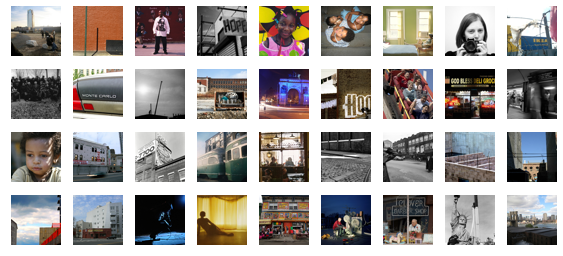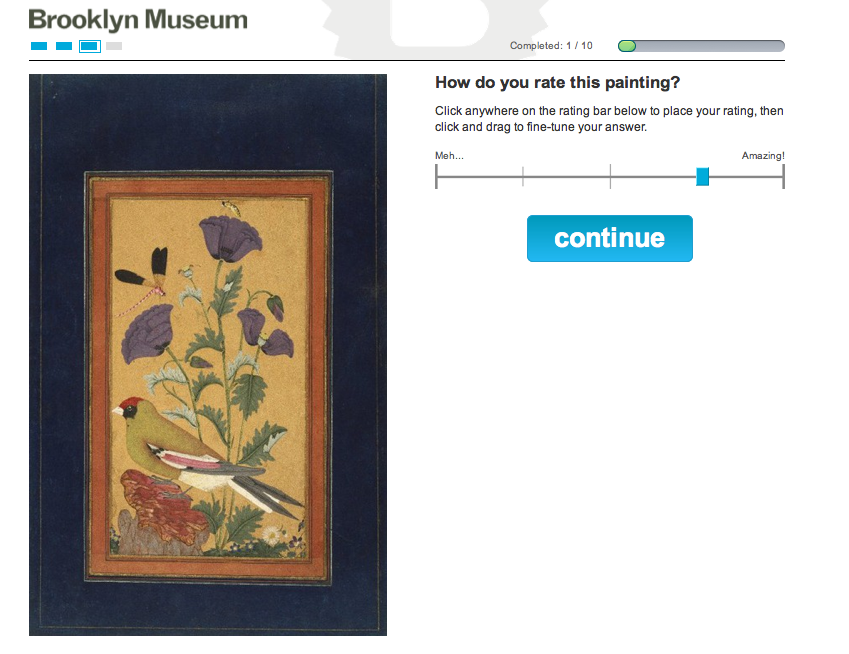Museum crowd-curation and the way we live now
Should more museums follow the Brooklyn Museum’s lead?
Recently, I helped curate Split-Second: Indian Paintings, a show for the Brooklyn Museum. To do so, I simply visited their website and participated in an online activity. It took me about ten minutes, and it involved briefly looking at images, clicking on those paintings that I found most intriguing and rating other paintings on a sliding scale.
My participation in this process got me thinking not only about Indian art, but also about how my own perceptions of art in general might be shaped, and how my aesthetic tastes might compare to the sensibilities of the general public. Even more interesting to me was that this experiment in crowd-curation felt like the inevitable extension of the movement towards a more participatory culture.
What is it?
Museum crowd-curation enables the general public to become a part of the curatorial process by helping to determine, through an online platform, the artwork to be included in a physical exhibition displayed in a museum’s gallery.
The Brooklyn Museum pioneered crowd-curation three years ago with its photography exhibition Click! . First launched through an open call for artists to submit photos related to the theme of “The Changing Faces of Brooklyn”, the artwork was then made available online for anyone to curate. Perhaps most interestingly, the Brooklyn Museum staff took a transparent and scientific approach to the experiment, publicly sharing data and thoughtful analysis every step of the way. Check out Brad's Technology in the Arts podcast with Shelley Bernstein from 2008 to learn more about Click!
Now, Bernstein and the folks at the Brooklyn Museum are offering a new spin on crowd-curation by injecting theories of connoisseurship to Split-Second: Indian Paintings. Based on ideas from the book Blink by Malcolm Gladwell, Split-Second seeks to explore how our first impressions might affect our perceptions of art as well as the production of a museum exhibition. In the end, we’re left with an engaging viewer/curator experience that subtly mixes the professional with the amateur.
Why is crowd-curation so intriguing?
Increasingly, we are becoming a culture of curators, especially in the virtual world. We spend our time organizing media according to preference, grouping our memories into online photo and video databanks, and “liking” and commenting on things that other people share. What this means is that arts audiences are coming to the gallery with a newly emboldened sense of organizing and presenting content. Arts organizations therefore need to play an active role by creating opportunities for meaningful engagement.
Organizations that are at the forefront of online audience engagement are presenting ideas that go beyond simply offering information about programming. Instead, they are experimenting with different ways that audiences can become co-creators of content, which can then lead to a sense of ownership in the institution. But crowd-curation should not be simply a matter of presenting art works and having a voting contest in the sense of American Idol. Rather, arts managers need to envision a place of meaningful dialogue between their organization and their audience.
Crowd-curation is exciting because it is a clear illustration of the changing dynamics of the audience/museum relationship. It takes creative online participation and literally translates the collective online vision into physical space. Along the way, it can stimulate creative thinking by:
- Getting the participant/curator to think about her own internal perceptions of art, and perhaps inspire her to dig even deeper through self-reflection. What struck me most in my experience as a curator of Split-Second was how successful the exercise was in getting me to think about not only the art in the show but also my own understanding of visual culture.
- Creating discussion, based upon the collective decisions of the audience, about big-picture questions, like: How is artistic value determined? Is general consensus achievable in determining artist merit?
By putting the internal and collective processes together, crowd-curation has the potential to achieve multiple levels of meaningful contemplation. Of course, arts managers may feel like they are taking a significant risk. They may fear that the artistic content chosen by the masses will not constitute a “quality” exhibition in the traditional sense. And, perhaps worse, if crowd-curation IS able to produce a quality exhibition, then what is the point of having all of these professionals around? However, as sites like Wikipedia or perhaps the “comments” section of any website have shown, opening up the production of content to crowds is precisely the time when professional, articulate viewpoints are needed most.
This is not to argue that crowd-curation methods should or will replace traditional curatorial models. In fact, it doesn’t make sense for all art museums to try it (based on a number of factors such as the nature of the audience, resources available, the nature of the exhibit, etc.) Even so, crowd-curation is an innovative approach to breaking down the barriers between art museum and audience, and it’s a fascinating reflection of the way we live now.


